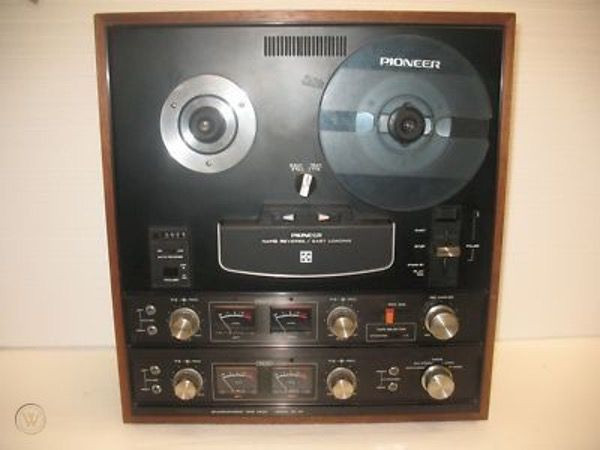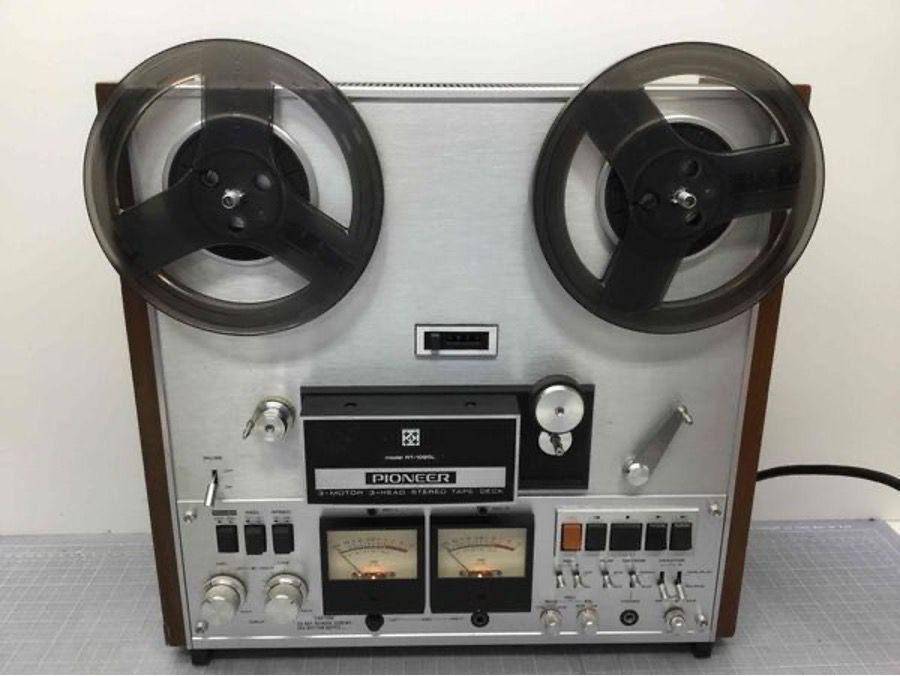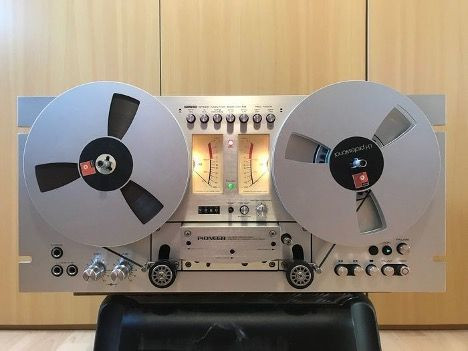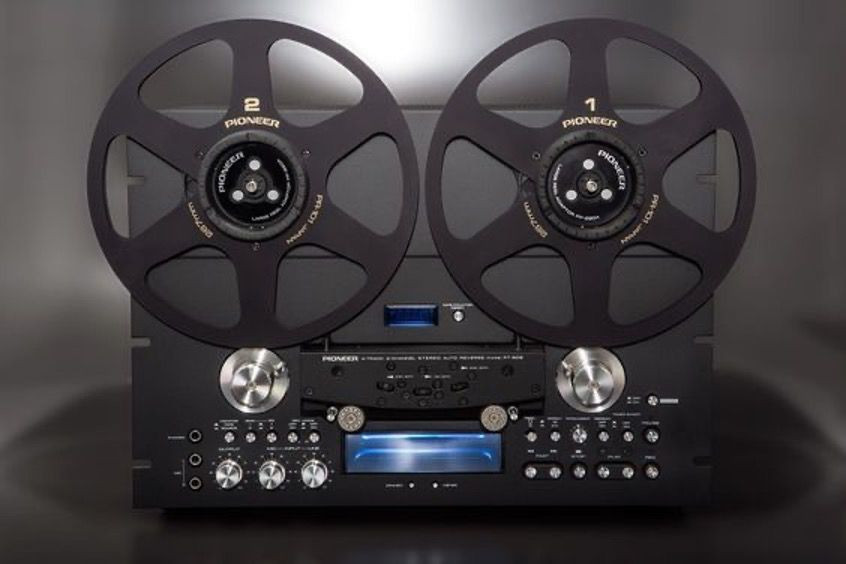Pioneer’s journey into the realm of audio technology is well-documented, particularly their early dominance in receivers and amplifiers. These vintage tube receivers and amplifiers are highly sought after by collectors and audiophiles, often fetching premium prices when found in excellent condition. The Pioneer SX series from the 1970s, renowned for their robust build quality, especially the high-power models, remain icons of audio engineering. However, the story of Pioneer Reel-to-reel tape decks, often referred to as pioneer reel machines by enthusiasts, is less widely known but equally fascinating.
While Pioneer established its reputation with receivers much earlier, their foray into reel-to-reel (RTR) tape decks came somewhat later. Despite this, they produced a range of models that have garnered attention in the vintage audio community. Among the earlier Pioneer reel models from the late 1960s and early 1970s are 7-inch machines, including both single-direction and auto-reverse versions. Models such as the T-115, the T-6600 auto-reverse, and the QT-74, an auto-reverse stereo/single-direction quadraphonic deck, represent Pioneer’s initial steps in this market. Like many reel-to-reel decks of that era, these early Pioneer models can be prone to mechanical issues, particularly with braking and tape transport systems. Despite their potential for high fidelity sound – achieving a 20kHz frequency response at 7 ½ IPS with good heads – long-term reliability can be a concern.

Model T-6600 Pioneer Reel to Reel Tape Deck – Vintage audio equipment from the 1970s showcasing the brand’s early entry into reel-to-reel technology.
Pioneer’s Popular RT Series Reel-to-Reel Decks
The later RT series marked a turning point for Pioneer in the reel-to-reel market, gaining significantly more popularity and recognition. This series included the RT-1020, RT-1011, and RT-1050, all designed to accommodate 10-inch reels, a feature appealing to serious audio enthusiasts and semi-professional users.
The RT-1011 served as the entry-level 10-inch pioneer reel deck in this lineup. It offered two speeds – 3 ¾ and 7 ½ IPS – and standard 4-track recording and playback, catering to the consumer tape format prevalent at the time.
Stepping up from the RT-1011, the RT-1020 shared a similar aesthetic but enhanced functionality. While maintaining stereo recording capabilities, the RT-1020 distinguished itself with a 4-channel playback head, enabling quadraphonic sound reproduction, a feature sought after during the quadraphonic audio era.
The RT-1050 represented Pioneer’s venture into the semi-professional market segment with its ½ track format and higher speed options of 7 ½ and 15 IPS. Despite utilizing RCA input and output jacks, commonly found in consumer equipment, the RT-1050 aimed to compete with established semi-pro brands like Teac/Tascam, Otari, and Fostex. Production numbers for the RT-1050 were relatively limited, making it a less frequently encountered model, though still appreciated by those in the know.

Pioneer RT-1020 Reel to Reel Deck – A popular model from the RT series known for its quadraphonic playback capability and robust design.
Strengths and Weaknesses of Early Pioneer RT Series Decks
The early RT series pioneer reel decks, while offering notable features, also came with their set of strengths and weaknesses:
Strengths:
- 3-Motor Direct Drive System: These decks employed a robust 3-motor design, featuring direct drive reel motors. These motors were generally reliable, although the belts for the capstan motor and counter were prone to degradation over time but were easily replaceable.
- Good Sound Quality: When equipped with heads in good condition and without significant wear, these decks delivered excellent sound quality.
- Durability and Longevity: The robust construction of these decks is evidenced by the number found with heavily worn heads, indicating extensive use over the years. Fortunately, the steel heads, if not excessively worn, could often be lapped or replaced, extending the deck’s lifespan.
- Solid No-Frills 10″ Option: The RT series offered a dependable and straightforward option for those seeking a 10-inch reel-to-reel deck without unnecessary complexities.
Weaknesses:
- Problematic Transistors: Similar to Akai decks of the same era which suffered from issues with 2SC458 transistors, these Pioneer RT decks were susceptible to failures of 2SC1344 transistors. These transistors were prone to causing distortion or intermittent channel dropouts. Replacing all of these transistors is often a necessary service for these models.
- Head Wear: The standard steel heads were prone to developing grooves from regular tape use. This wear could lead to a drop in high-frequency response as the tape loses optimal contact within the worn groove. Head lapping could often restore performance.
- Microswitch Failures: The microswitches behind the function buttons, especially the ‘play’ button, were known to fail over time due to the current passing through them, causing pitting and eventual malfunction. These specific switches could be challenging to source replacements for, often requiring scavenging from parts decks or finding them on online marketplaces.
- Function Switch Locking Mechanisms: The locking mechanisms for the function switches could corrode and seize, sometimes resulting in buttons sticking or the stop button becoming permanently engaged. Addressing this issue involved removing the switch PC board for cleaning and lubrication.
Pioneer RT-701 and RT-707: Rack-Mountable 7″ Decks
Pioneer expanded their pioneer reel offerings with four silver (and a rarer black finish) rack-mountable reel-to-reel models: the RT-701 (single-direction 7″ deck), the RT-707 (auto-reverse 7″ version), and the RT-901 and RT-909 (single and auto-reverse versions for up to 10″ reels). The popularity of these models warranted individual attention and recognition.
Designed to integrate seamlessly into Pioneer’s high-end ‘Spec’ series rack systems, these decks offered both aesthetic appeal and functional performance. While rack ventilation could be limited when fully loaded, the visual impact was undeniable. Their standard 19″ rack compatibility also increased their appeal beyond dedicated Pioneer systems.
Despite visual similarities, the internal architecture of the 701/707 and 901/909 series differed significantly. The RT-707 utilized a direct-drive capstan motor, known for its reliability, and direct-drive reel motors, contributing to stable and accurate tape handling.
Like other Pioneer reel to reel decks of the era, the 701/707 series employed steel heads. Wear was a common issue, often necessitating head lapping to address level fluctuations caused by even minor grooves.
Pinch roller rubber and belts in these models were known to degrade, and pinch rollers could seize due to accumulated residue on their shafts. This could lead to speed inconsistencies or wow and flutter during recording and playback. However, cleaning and reassembling the pinch roller mechanism was a relatively straightforward maintenance task.

Pioneer RT-707 Reel to Reel Deck – A rack-mountable auto-reverse model known for its stylish design and generally reliable performance.
Pioneer 701/707 Strengths and Weaknesses:
Strengths:
- Reliability and Sound Quality: Generally dependable and capable of producing high-quality sound.
- High-End 7″ Deck Choice: Excellent options for a high-end 7-inch reel-to-reel deck, available in both single-direction and auto-reverse configurations.
- Serviceability: Typically easy to service, with relatively few common electronic issues.
- Motor Reliability: Motors were generally robust and reliable.
Weaknesses:
- Rubber Degradation: Original pinch rollers and counter belts were prone to deterioration and often required replacement.
- Pinch Roller Bearing Gumming: Pinch roller bearings could become sticky or gummed up, but this was easily rectified with cleaning.
- Forward/Reverse Indicator Lights (RT-707): The indicator lights for forward and reverse modes on the RT-707 were known to burn out. Many owners opted to replace them with more durable LED lights.
Pioneer RT-901 and RT-909: Top-of-the-Line 10″ Decks
The RT-909 represented the pinnacle of Pioneer’s pioneer reel technology and the most popular 10-inch model from the brand. It shared the attractive aesthetics of the 701/707 series but with an even greater visual appeal, especially when paired with the sought-after 10-inch Pioneer reels, now highly valued in the vintage audio market.
The RT-901 and 909 models diverged significantly in design and construction from the 70X series. The 90X series incorporated more complex logic circuitry, implemented on a PC board behind the function buttons. The transport board was also more sophisticated, employing trimpots for tape tension adjustment, unlike the simpler power resistor system in the 70X series.
The motor in the 90X series was a smaller 24-volt unit, similar to those used by Teac in many of their decks. Notably, the 90X models featured a dual-capstan drive, a step up from the single-capstan design of the 70X series. Using the correct capstan belt with precise thickness and diameter was critical for proper operation of the 90X decks. Incorrect belt specifications could lead to tape drooping and tension issues.
The motors in the 90X series, being brush-type, were subject to brush wear with heavy use. This wear contributed to an increase in the price of replacement motors on the used market. If the capstan belt stretched and wrapped around the motor pulley, it could cause the motor to stall and potentially burn out rapidly.
Troubleshooting the logic board and tape transport board could be challenging, as was diagnosing issues with the fluorescent meter logic board, which utilized TTL-based circuits. While replacement boards could often be found on the secondary market, the logic board was particularly difficult to remove and reinstall.
Despite these complexities, a properly serviced RT-90X series pioneer reel deck remains a prized addition to any vintage stereo system, offering excellent performance and iconic aesthetics.

Pioneer RT-909 Black Edition Reel to Reel Deck – A rare and highly collectible black version of the RT-909, commanding significant value in the vintage audio market.
Pioneer RT-90X Strengths and Weaknesses:
Strengths:
- High-Performance and Reliability: A generally reliable, high-end deck capable of delivering stellar audio performance.
- Visual Appeal: The blue fluorescent VU meter display, matching other Pioneer components, added a distinct ‘coolness’ factor.
Weaknesses:
- Capstan Motor Vulnerability: Degraded belts and pinch roller rubber could potentially damage or destroy the capstan motor if not addressed promptly.
- Capstan Motor Weakness: The capstan motors were considered somewhat less robust compared to other components.
- Tape Tension Lever Seizing: Tape tension levers could become stiff or seize due to hardened grease.
- Head Wear: Steel heads were still susceptible to wear with prolonged use.
- Complex Electronics: Logic and VU meter PC boards could be challenging to troubleshoot.
- End-of-Tape Microswitch Failures: End-of-tape microswitches could fail due to corrosion and wear, although replacement was relatively straightforward.
Pioneer RT-2022 and RT-2044: Semi-Pro and “Portable” High-End Models
The RT-2022 and RT-2044 models represent a less common chapter in Pioneer’s pioneer reel history. Based on the RT-1050 platform, these decks were offered in ½ track and 4 track (4-channel) versions. They retained the reliable transport of the RT-10XX series and offered high-speed operation at 7 ½ and 15 IPS. Pioneer positioned these models towards the semi-professional market and as high-end “portable” options, including deck covers that snapped onto the front panels and carrying handles.
These models featured front-panel bias and equalization adjustments, along with microphone and line mixing capabilities. While well-engineered, finding intact front covers for these models is rare due to the pressboard material’s susceptibility to damage. The heads were similar to the 10XX series, resulting in comparable sound quality.
A notable weak point was the specialized cables connecting the preamplifier units to the transport. These multi-pin cables were proprietary and difficult to replace if lost, as the connectors were no longer in production. Early Sony reel-to-reel video recorders utilized similar connectors for their deck-to-monitor connections.

Pioneer RT-2022 Reel to Reel Deck – A rarer semi-professional model with high-speed capability and portable design elements.

